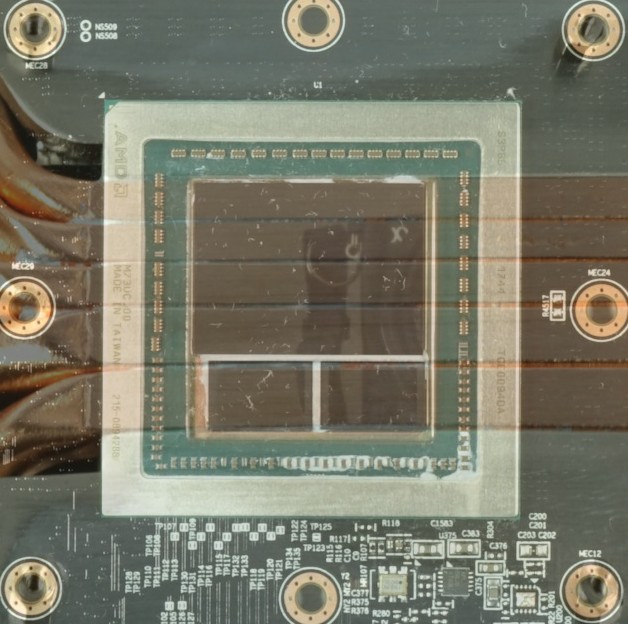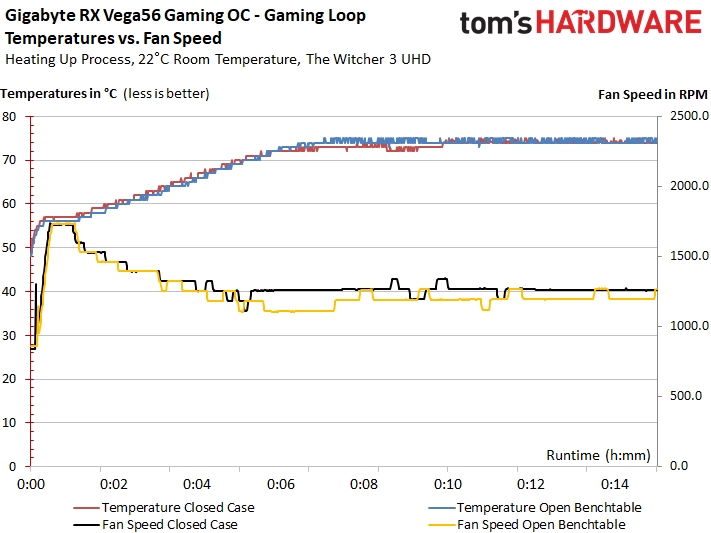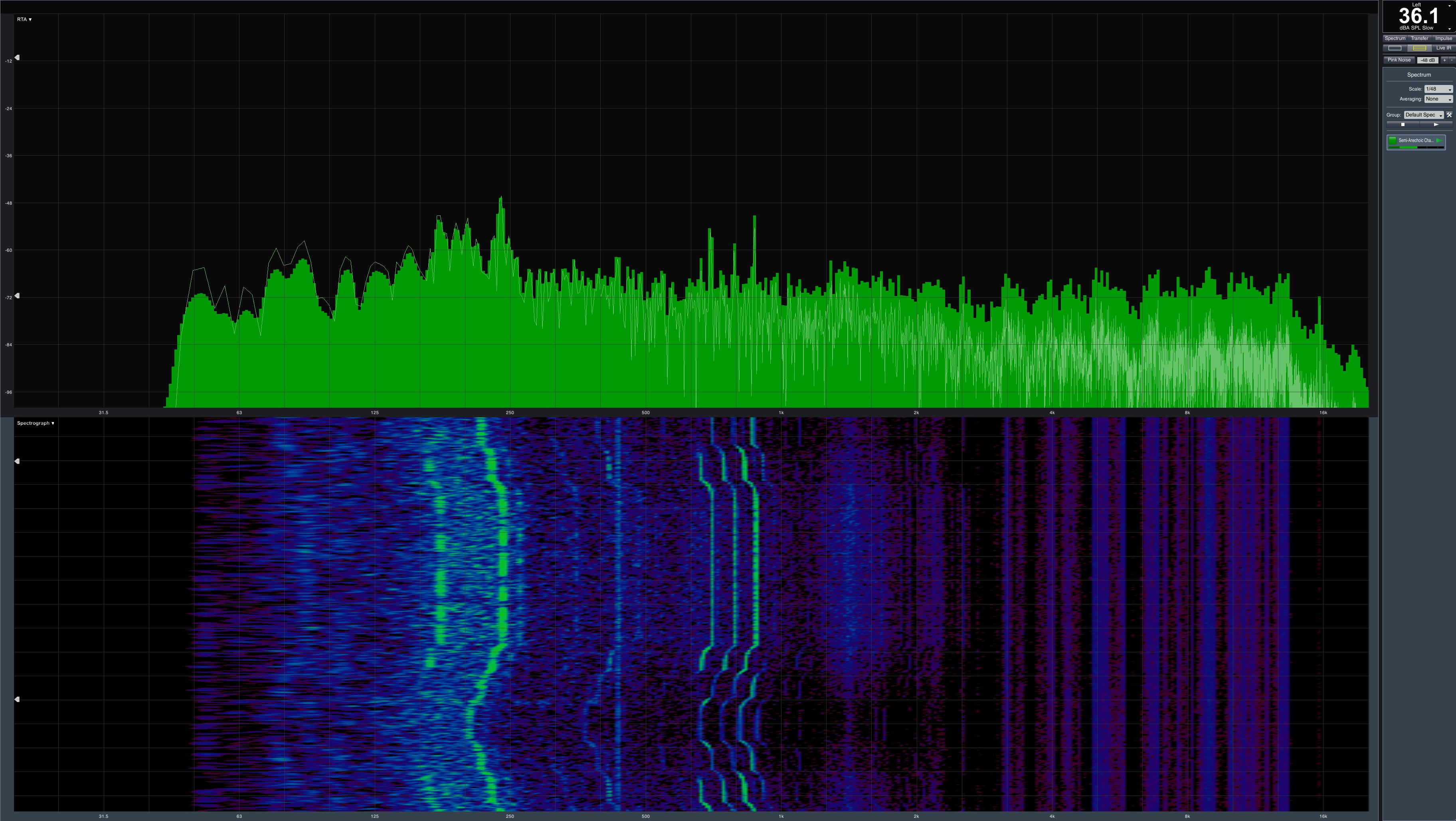Hot Vega: Gigabyte Radeon RX Vega 56 Gaming OC 8G Review
Why you can trust Tom's Hardware
Cooling & Noise
Cooling Solution & Backplate
There’s a direct relationship between power consumption and waste heat, and it's the thermal solution's job to cope with the latter. This is exactly where Gigabyte's card reveals the compromises made to keep costs low, even if the cooler still mostly works well.
Since the backplate is made of relatively thin aluminum, material is embossed in certain places to improve stiffness and add a bit of visual flair. A flattened heat pipe is glued to the backplate as well. Its purpose is to dissipate waste heat from the aforementioned MOSFETs across the plate more effectively. Other components on the PCB's back side are cooled directly using thermal pads.
Gigabyte coats the inside of the backplate in black, so thermal energy from components on the PCB is absorbed more easily. As you can see, pads help cool the area opposite AMD's Vega 10 GPU, along with nearby capacitors.
| Cooling System Overview | |
|---|---|
| Type | Air cooling |
| GPU Cooling | Heat pipe direct touchAluminum sink |
| Cooling Fins | Aluminum, vertical orientationNarrow configuration; partially inclined |
| Heat Pipes | 2x 8mm + 3x 6mmCopper composite material |
| VRM Cooling | GPU and memory VRM via cooling frame |
| RAM Cooling | Memory cooling of HBM2 modules via heat pipe |
| Fans | 2x 9.5cm fans (10cm opening), 11 bladesSemi-passive control |
| Backplate | AluminumCooling function with heat pipe and thermal pads |
Two 8mm and three 6mm heat pipes made of composite material are responsible for transporting heat from the GPU and distributing it through finned areas of the sink. Heat sinks over some of the voltage converters also help prevent problematic hot-spots from developing.
Although we've seen many negative examples of heat pipe direct touch cooling, this approach can certainly be effective if it's implemented properly.
Our overlay shows that, in this case, Gigabyte's solution is a good fit. The heat pipes are flattened no more than necessary to achieve complete and functional coverage. As a result, the temperature range difference for the GPU, memory, and hot-spot are only 2°C above what we measured from Sapphire's vapor chamber-based cooler. That's extraordinary for a normal heat sink.
Fan Curves & Noise
Semi-passive operation is implemented though an on-board controller, meaning that software like WattMan still reports a rotational speed even after this controller deactivates the fans. Fortunately, the truth reveals itself to a tachometer with a laser sensor. Using this hardware, we're able to map out the fan curve, which appears tuned to keep AMD's GPU from exceeding a 75°C temperature target.
Get Tom's Hardware's best news and in-depth reviews, straight to your inbox.
After a period of heavy cooling during warm-up, the fans slow down and stabilize. However, Gigabyte tried a little too hard to keep noise down with its small cooler, resulting in fan speeds that have to speed up and slow back down under load. It certainly would have been possible to specify a faster, more constant speed setting. This would have evened out the curve and helped on-board components run a little cooler, too.
Little changes during our stress test. In short, the card's two fans perform quite well, but would definitely benefit from slightly higher rotational speeds.
As a consequence, the Radeon RX Vega 56 Gaming OC 8G has no margin left for lower fan speeds. This setup is too heavily optimized for noise, as the following table shows:
| Fan RPM & Noise Measurements | |
|---|---|
| Fan RPM, Open Test Bench, Maximum | 1731 RPM |
| Fan RPM, Open Test Bench, Average | 1134 RPM |
| Fan RPM, Closed Case, Maximum | 1730 RPM |
| Fan RPM, Closed Case, Average | 1264 RPM |
| Noise (Air) Range | 33.4 (Minimum) to 40.8 dB(A) |
| Noise (Air) Average | 36.1 dB(A) (Warmed up) |
| Noise (Air) Idle | 0 dB(A) |
| Noise characteristics / Subjective Impressions | Low-frequency bearing noiseSome motor noises below 1 HzModerate air and turbulence noisesHardly any voltage converter noise |
This snapshot illustrates the entire frequency range of our laboratory measurements, adding some data to our subjective observations. The alternating fan speeds we mentioned previously are clearly visible.
An average of 36.1 dB (A) is more than acceptable for such a powerful card. In fact, the outcome is almost too good. We would have tolerated a bit more noise to get a stable fan curve. Fortunately, you could solve this on your own with a bit of manual adjustment.
MORE: Best Graphics Cards
MORE: Desktop GPU Performance Hierarchy Table
MORE: All Graphics Content
Current page: Cooling & Noise
Prev Page Temperatures, Clock Rates & Overclocking Next Page Conclusion
Igor Wallossek wrote a wide variety of hardware articles for Tom's Hardware, with a strong focus on technical analysis and in-depth reviews. His contributions have spanned a broad spectrum of PC components, including GPUs, CPUs, workstations, and PC builds. His insightful articles provide readers with detailed knowledge to make informed decisions in the ever-evolving tech landscape
-
marcelo_vidal With the pricey from those gpus :) I will get an 2400g and play 720P. maybe with a little tweaking I can boost to 1920x1080Reply -
Sakkura This thing about board partners only getting a few thousand Vega 10 GPUs goes back many months now. Has AMD just not been making any more? What the heck is going on?Reply
Seems like Gigabyte did a really nice job making an affordable yet effective cooling solution for Vega 56, it's really a shame it goes to waste because there just aren't any chips available. -
CaptainTom To those complaining about the low supply (and resulting high prices) of AIB cards:Reply
It's because the reference cards are still selling very well (at least for their supply). If vendors can sell the $500 Vega 64 for $600 and sell out, why would they bother wasting time on any other model? -
g-unit1111 Reply20576533 said:To those complaining about the low supply (and resulting high prices) of AIB cards:
It's because the reference cards are still selling very well (at least for their supply). If vendors can sell the $500 Vega 64 for $600 and sell out, why would they bother wasting time on any other model?
That's because miners are the ones buying the cards as fast as they come in stock. It's us gamers and enthusiasts that are waiting for the high performance models. Bad thing is, we don't matter to the bottom line. All they see and want is our precious money, and they don't care what model they sell to us. -
aelazadne Because, the Vendor's making money doesn't equal AMD making money. AMD is losing market share in the GPU scene. With Vega unable to keep up with demand AMD is losing customers who would have bought Radeon's but instead go with Nvidia due to availability. The lack of Availability stemming from August and the fact that even now in early 2018 the Vegas are over priced and hard to find ruins customer confidence. In fact, this situation is so bad that the only people benefitting are the people gouging both Nvidia cards and Radeon cars because at this point there is NO COMPETITION.Reply
Also, just because you are gouging doesn't mean you are making money. AMD has to make money and they need to sell these things in a certain volume. In their contracts with Vendors, they will require their vendors to sell a certain amount of vegas in order to order more. Due to scarcity the only companies making money are Retailers. AMD is going to have to address this issue otherwise their investors will begin to come after them for bungling so bad that their market share dropped so bag. Literally, the intel screw up plus Ryzen being good has been a godsend for AMD, they do not need a declining GPU market share sparking a debate with investors over whether AMD should get out and play the Intel game. -
bit_user Reply
I really appreciate the thorough review.20575687 said:...
The super-imposed heatpipes vs. GPU picture was a very nice touch. For any of you who missed it, check out page 6 (Cooling & Noise) about 1/3 or 1/2 of the way down.
-
bit_user Reply
I think you're too cynical. It's an ASIC supply problem. The AIB partners would probably spend the time if they could get enough GPUs to sell custom boards in enough volume to offset the overhead of doing the extra design work.20576533 said:It's because the reference cards are still selling very well (at least for their supply). If vendors can sell the $500 Vega 64 for $600 and sell out, why would they bother wasting time on any other model?
The only real way out of this is for AMD to design a more cost-effective chip with the graphics units removed. That will divert miners' interest away from their graphics products. -
bit_user Almost as surprising to me as how much more oomph they got out of Vega 56 is how well the stock Vega 64 is holding up against stock GTX 1080. Is it just me, or did AMD really gain some ground since launch?Reply





